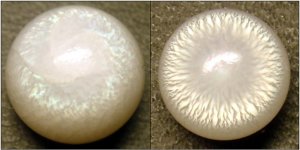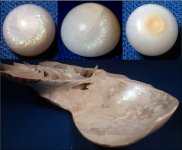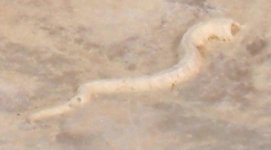SteveM
Well-known member
- Joined
- Jan 29, 2007
- Messages
- 2,026
Shell and blister received today, along with 15 other purported Nautilus pearls resulting from an extensive expedition mounted to find the blister. All from private collections, regarded as lucky talismen for years without a doubt about being Nautilus.
The blister and the shell do go together, the hint of bluish color in the flame convincingly matching the nacreous iridescence where the nacre is exposed on the shell. In fact, in viewing this pearl closely, early conjecture in this thread regarding hybridization holds up. As has been documented, the Nautilus continuously produces both nacreous and non-nacreous shell material. At the juncture of the outer shell and the septa (chamber walls) there is even room for some ambiguity. Could it be that the mollusk simply can't decide what it wants to use in making the pearl (or uses the first available substance)?
The pearl on the right (7mm button, 1.9ct) can clearly be written off as Tridacna. But I think I'll keep it. Transparency allows that amazing flame to be seen practically to its core.
The blister and the shell do go together, the hint of bluish color in the flame convincingly matching the nacreous iridescence where the nacre is exposed on the shell. In fact, in viewing this pearl closely, early conjecture in this thread regarding hybridization holds up. As has been documented, the Nautilus continuously produces both nacreous and non-nacreous shell material. At the juncture of the outer shell and the septa (chamber walls) there is even room for some ambiguity. Could it be that the mollusk simply can't decide what it wants to use in making the pearl (or uses the first available substance)?
The pearl on the right (7mm button, 1.9ct) can clearly be written off as Tridacna. But I think I'll keep it. Transparency allows that amazing flame to be seen practically to its core.
Attachments
Last edited:



